August 18, 2003 |
ISSN 1550-9214 |
GM's Warranty Reserves:Both GM and Ford made sizeable withdrawals from their reserve funds during the second quarter. GM cited increased product quality. But analysts said the move lowered earnings quality. Ford said nothing, and nothing was said. What's behind the changes of estimate?
That information came straight from GM's July 17 press release: Here's the news that wasn't there: Without the removal of $264 million ($199 million after taxes) from the warranty reserve fund, GM's automotive group probably would have declared a net loss, rather than a $140 million net profit. Last year, such changes in warranty estimates would have gone unnoticed. But this year, thanks to newly-available details about the warranty accounting policies of manufacturers, the details are there for all to see. Creative Accounting?Some immediately said GM was managing its earnings by transferring money in and out of its warranty reserve. In a July 17 Reuters article about GM's earnings report, author Michael Ellis reported that analysts told him they thought the company was artificially boosting its lackluster earnings by cutting back on warranty reserves. Equity analyst Bill Turner from Bank One Investment Advisors was quoted as saying, "It certainly lowers the quality of earnings." Ironically, improvements in the quality of the company's vehicles were cited as the major reason for the decrease in warranty reserves. In the second quarter, warranty expense was $1.036 billion, or 2.7% of warranted product sales. In the first quarter of 2003 and during all of 2002, that expense was closer to 2.8% of auto sales. The Ford Motor Co. also made a huge change in estimate during the second quarter, but it slipped by largely unnoticed by the automotive press. It most likely was overlooked because unlike GM, Ford didn't overtly mention the adjustment in its July 16 earnings announcement, though it was detailed in the company's 10-Q report. There, the company reported a $113 million downward change in estimate in the second quarter.
It is therefore not an exaggeration to say that warranty made the difference between profit and loss at both Ford and GM during the second quarter. It's probably not the first time this has ever happened, but it most certainly is the first time it happened in public. So let's celebrate the bounty brought to us by the Enron and WorldCom scandals with another thousand or so words about warranty changes of estimate. If the dirty truth be told, the process of estimating future warranty costs is highly arbitrary, and is highly dependent on the mood of CFOs and auditors. Take a look at the July 7 and March 24 issues of Warranty Week for examples. Sometimes they're in a conservative mood, and sometimes they're in an optimistic mood. But predicting future costs is a lot like grabbing an umbrella on the way to work. It's a decision based as much on probability as it is on emotions. You make your best initial guess of future warranty costs as the product leaves the factory, then you adjust it up or down based upon actual experience in the field. But even if the estimate is the output of a third order polynomial, it's still a prediction. As with weather forecasts, just because they're run on a supercomputer doesn't make them 100% accurate. It's just that when billions are involved, as they inevitably are at GM and Ford, these guesses can be off by $100 million or more, even when the rates are off by only a few tenths of a percent. A tenth of a percent may not sound like much, but each 0.1% drop in GM's reported claims rate corresponds to around $46 million in additional operating income each quarter. With roughly 27 to 28 million vehicles under warranty at any given point in time, even a small savings per quarter per vehicle is enough to justify a $268 million change of estimate. The Quality StoryIt's a quality story. If the quality of a vehicle made in the first half of 2002 is higher than anticipated, chances are its lower-than-projected warranty costs have already been observed by midyear 2003. These quality patterns usually develop within the first year after a car leaves the factory, so it's entirely possible that a 0.1% observed drop in the company's total claims rate masks a much more substantial drop in the claims rates for just the most recently made vehicles. Put another way, perhaps a massive drop below the 2.8% historical rate has been observed in recent sales, and it is now beginning to manifest itself as an 0.1% drop for the entire installed base. Future results will confirm or refute that theory. Sheri Woodruff, GM's manager of financial communications, told Warranty Week that the company recently realized that vehicle quality was higher than was first estimated, and therefore the original estimates for future warranty costs also were on the high side. Sales were up in 2002, and GM used historical rates to reserve for future warranty costs. In hindsight, that turned out to be an over-allocation, because actual costs have come in below historical experience. "We're having better-than-expected quality," Woodruff said. So reserves were adjusted to reflect the new estimates for future costs. Not only is that news reflected in the company's internal quality reports and external studies. It also is reflected in the company's bottom-line results, to the tune of $199 million after taxes. "It's terrific news," she concluded. Because GM manufactured more vehicles in 2002 than in 2001 (and more in the first half of 2002 than so far in 2003), the company routinely put more aside to cover future warranty costs, Woodruff said. "But then as sales increased, we realized that quality was much better." Woodruff laughed when informed that some analysts thought her company's earnings were of lower quality because of their source. "I wouldn't guess what people are thinking," she said. "This, we believe, is a good development for the right reasons." Quality increased, costs declined, and reserves were adjusted accordingly. End of story? Not quite. There are numerous "on the one hand, on the other hand" arguments to be made that either support or contradict the change of estimate. Thanks to the expanded warranty disclosure rules now in effect, those arguments can now be made in detail. The quarterly disclosures now expected of warranted product manufacturers show that GM's warranty reserve continues to be the largest by far, but its size actually has contracted a bit during the first half of this year. GM's reserve shrank from $8.856 billion at the end of 2002 to $8.765 billion at the midway point of 2003. In contrast, between Dec. 31, 2001 and Dec. 31, 2002, the reserve fund grew by $679 million, to a level where GM had 25 month's worth of claims in its reserve. Now, despite the reduction in the fund's size, GM still has 25 months of reserves on hand, because the falling claims rate has compensated for the smaller fund balance. More Financial DetailsOverall, GM reported a $901 million figure for net income, and $48.3 billion in total revenue. Financing operations accounted for $843 in earnings and $7.6 billion in revenue. Hughes reported earnings of $22 million on revenue of $2.4 billion. It was the automotive group that saw the tightest margins, with only $140 million net income on $38.25 billion in revenue. Within GM's four automotive sales regions, two reported net income and two reported net losses. GM Asia/Pacific did best in the quarter with $163 million in net income. GM North America had net income of $83 million. GM Europe had a $3 million net loss. GM Latin America/Africa/Mid-East had a $103 million net loss. A year ago in the second quarter, GM's total company net income was $1.29 billion. Worldwide automotive net income was $1.07 billion. North American automotive net income was $1.28 billion. So while total net income fell 30% year-over-year, automotive net income plunged 87%. Automotive income from just the North American sales region fell nearly 94%. Without the warranty change of estimate, GM's auto group would have declared a net loss. That much is true. But it's also true that minus the massive cost of a direct hit on GM's Oklahoma City plant by a tornado, the auto group would have been profitable with or without the warranty adjustment. There's a dozen other "what if?" scenarios that could have changed the earnings picture. But with books with titles like "The End of Detroit" now in the pipeline, one can't help but think that perhaps the lack of a net loss was disappointing to some market watchers. Of course, the warranty adjustment was discretionary, while the $168 million cost of the May 8 tornado was unpredictable. And this is why the analysts said the change in estimate reduced the quality of earnings. In the good times, GM adds to its reserves, while in the bad times it takes money out. It's not supposed to be a savings account. It's supposed to be more like a trust fund, containing money put aside to pay future claims -- not to help a company "make its numbers" in a tough quarter. The data somewhat supports this view. Last year, when auto profits were plentiful, GM reported an upwards $323 million change in estimate, but no accompanying decrease in quality, and no real spike in claims. In the tough market this year, where price cuts are outpacing volume sales gains, the net downward change in estimate has been $264 million (there also was a $4 million upwards change in estimate in the first quarter). The problem with this theory is it assigns ulterior motives to a process that already is somewhat arbitrary. Already, manufacturers can choose to accrue for a vehicle's total predicted warranty costs all at once as the vehicle is sold, or to accrue for it in the period in which the warranty cost is most likely to arise. Manufacturers can plan conservatively and find out later they've over-allocated, or they can use optimistic assumptions and hope for the best. The only rule is that they must disclose the accounting policy and methodology used in determining their liability for product warranties, and that they must include a warranty table in all interim and annual financial statements. Let's face it, GM and Ford are conservative companies. That's how companies get to be 100 years old. They may not plan for recessions, wars, blackouts, or tornados, but they leave themselves a cushion to get them through the tough times. "It's just the way we approach the business," Woodruff said. "I know GM tends to be very conservative with its accounting." It turns out that GM's cushion may be as much as $3.3 billion in size. Ford's cushion could be as much as $1.2 billion. If this is true, both companies could go on making similar downwards changes in estimates for the next eight or ten quarters and still be above the U.S. manufacturing industry median. This is perhaps not something analysts are now figuring into their dire predictions for the future of Detroit-based automakers. GM and Ford have enough excess funds in their warranty reserves to add an extra hundred million to net income each quarter for the next few years -- and still have enough to pay claims. Manufacturing Industry MedianOf the 460 U.S. manufacturers who have reported both warranty claims and warranty reserves so far this year, 230 carried reserves equal to or greater than 15 months. This means that at current rates of spending, their reserves would pay for 15 more months of claims, even if they put nothing aside out of current sales. So let's adopt 15 warranty-months as the unofficial median size of a U.S. manufacturer's warranty reserve fund. Why is the median so important? It reflects the planning assumptions of 460 different CFOs, each of whom make a decision that the reserves-to-claims ratio they select is the one most appropriate for their product lines and warranty durations. It's not the measure of the "right" ratio. It's merely the point at which half the planning assumptions are above and below. It's a much more useful measure than the simple average of 460 ratios, which stands at nearly 29 months, or the weighted average, which is closer to 18 months. Those measures are considerably skewed because the 460 different ratios are literally all over the chart. They range from 0.5 months to 542 months, although more than 200 are within a much tighter range of 10 to 25 months. Still, that means more than half of all manufacturers are far outside that middle range -- either very conservative or very, very optimistic. The standard deviation is 55, but all you need to see the enormous spread is a quick look at Figure 1. A plot of the 255 largest warranty reserve funds, along with their reserves-to-claims ratios, is represented in the chart below. The absolute size of the warranty reserve fund is plotted along the horizontal, while the reserves-to-claims ratio is plotted along the vertical. The red dots in the top half represent companies above the median. The blue dots in the bottom half represent companies below the median. Their distance from the median reflects how much they are above or below the consensus. Figure 1 Warranty Reserves of the Top 255 U.S. Manufacturers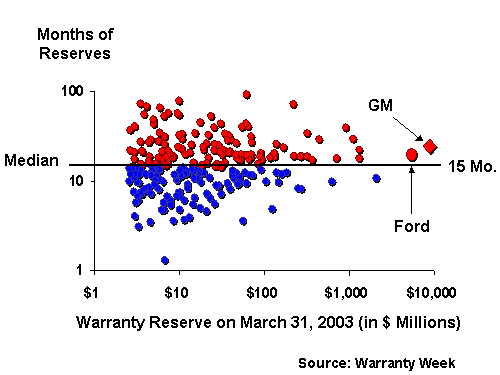 By the way, if for some reason there's no graphic in the space above, all the charts can be found on the Web. Because of heightened security concerns, some email administrators now routinely block the display of all graphics files. Readers can use their Web browsers to get around this problem. GM is represented by the big red diamond to the extreme right. The large red circle nearby represents Ford. The closest blue dot represents Hewlett-Packard Co. The four red dots in a Big Dipper-like cluster represent Dell Inc., General Electric Co., United Technologies Corp., and Boeing Co. All look close to the median, but this is due to the use of a logarithmic scale on both axes. Because the warranty reserves depicted in this chart vary between $2.5 million and $8.765 billion in size, and also because of the great variance in the reserve-to-claims ratios, there is simply no other way to chart the data. The truth is that because of the massive size of their reserve funds, these six companies would have to add or subtract hundreds of millions of dollars from their reserve funds to move close to the industry median. In GM's case, the $8.8 billion it has in its reserve could be reduced in size to $5.5 billion. If quarterly warranty spending remains within its current range of $1 to $1.1 billion, the remaining amount would still be enough to fund five future quarters, or 15 months. In Ford's case, the $5.4 billion it now has in its reserve fund could safely and gradually be reduced to $4.2 billion. If quarterly warranty spending remains within its current range of $834 to $860 million, this amount would be enough to fund five future quarters, or 15 warranty-months. Another way for GM and Ford to move closer to the median would be for them to somehow raise their claims rate. For instance, they could 1) make less durable vehicles, 2) reduce warranty chargebacks to suppliers, or perhaps most intriguingly, they could 3) lengthen passenger car warranties to match the best of Chrysler, Hyundai, and others. Of the possibilities, 3) seems to fit best with the current "increasing quality" message. In fact, given that GM and Ford are below the industry median in terms of warranty length (see the April 22 issue for a comparison), such a lengthening would be a shrewd marketing move. This is not to say that Ford and GM should run their businesses based on what everyone else is doing. The size of a company's warranty reserve should reflect what planners know about their products in the field under warranty. If a manufacturing defect has been found and a major recall is likely, they have to prepare financially for it. But that's why we're using the median as our measure. The warranty-month ratio turns an internal and arbitrary process into a dot on a chart, based solely on that internal data. The median spotlights how conservative or optimistic a company is in relation to 459 other manufacturers. We're not saying that Paccar, Cummins, John Deere, or Navistar do a better job of predicting warranty costs simply because they're closer to the median than either GM or Ford. And we're not saying that product type or length of warranty should not be a factor. We're just saying that the median represents the consensus of 460 independent decisions, and that a move by either Ford or GM towards that consensus level could be justification enough for the removal of billions of dollars from their reserve funds. Automotive Industry MedianReducing the scope to look at just the automotive companies doesn't change the results by much. If the definition of an automotive manufacturer includes off-road and construction vehicles as well as manufacturers whose product lines are only partially automotive, the median for the top 80 "automotive" manufacturing companies lies around 17 warranty-months. The weighted average is 21 months. But of course, the skewing effect of Ford and GM is even more pronounced in this case, given the absence of the big computer and aerospace vendors from such a list. Together, Ford and GM account for 45% of all reported U.S. manufacturing company warranty reserves as of March 31, 2003. They account for 78% of the warranty reserves of just the 90 largest U.S.-based automotive parts and vehicle manufacturers. The size of GM's and Ford's warranty reserves is more noticeable on a chart plotted with a linear scale, as is done below. To make it even more obvious, all but the 30 largest warranty reserve funds have been eliminated. In the latest quarter, GM moved its fund balance by a net $100 million to the left, while Ford moved about $50 million to the left. The point is, they each could have moved a lot further. In the chart below, the effect of a $3.3 billion move by GM and a $1.2 billion move by Ford are considered. Figure 2 "Right-Sizing" GM's and Ford's Warranty Reserves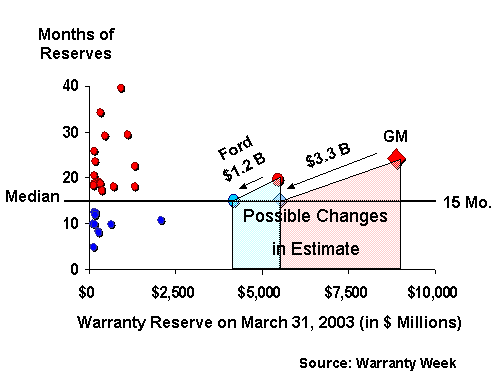 As mentioned, both GM and Ford are currently towards the high side of that middle range of 10 to 25 warranty-months in reserves. By making the above depicted changes of estimates, both would arrive at the U.S. manufacturing industry median. One word describes why they might not want to do that: Firestone. If a calamity of that size somehow crept back into the product line, having 20 to 25 months' of reserves on hand would serve the companies well. Then again, it would have to be quite a calamity to justify tying up $1.2 to $3.3 billion in excess reserves. Perhaps they might take only half that amount out, so they sit at perhaps the 18-month level? The point is, if they could justify the removal of billions in the future, why should they be criticized for removing a few hundred million now? GM spokesperson Woodruff declined to speculate about the size of any future changes of estimate. "I don't want to guess the future," she said. "I would say we will continue to look at how we manage this liability, but I don't want to guess about what we might do in the future. And I will say that it's something that we track, and we're always looking at our cash management for things that make sense to us. So it's something that we continue to look at." If the quality improvements prove to be sustained, however, expect more to come. "I think that we will be delighted if we continue to see that our products are performing in a way that allows us to do this for the right reasons," Woodruff said. One Level DeeperThere are other ways to look at GM's quality improvements and correspondingly lower warranty costs. One is to measure outlays against vehicle sales revenue over the past six quarters. Another is to spread total outlays across the total number of vehicles on the road during the period that were covered by a warranty. Both methods have one big problem: GM reported only annual figures for 2002, so the warranty spending data for four of the past six quarters will have to be a numerical average. This use of estimates is noted in the two charts below by the dotted line between the points. In the first chart below, it's obvious that GM's quarterly outlays for warranty has been remarkably stable over the past six quarters. The high and low quarters are within a few percentage points of the average. Yet the recent decrease in the percentage of sales spent on warranty is equally obvious in the drop of the red line from 2.8% to 2.7%. Figure 3 Six Quarters of GM's Warranty Expense | ||||||
|


 When General Motors Corp. last month
When General Motors Corp. last month  Ford reported no reason for the change, but so far has suffered no criticism for making it, nor for the failure to point it out. It simply didn't make the news. What makes this "no news here" aspect all the more amazing is that Ford reported only a slim $3 million pre-tax profit in its automotive sector, on $34.2 billion in sales.
Ford reported no reason for the change, but so far has suffered no criticism for making it, nor for the failure to point it out. It simply didn't make the news. What makes this "no news here" aspect all the more amazing is that Ford reported only a slim $3 million pre-tax profit in its automotive sector, on $34.2 billion in sales.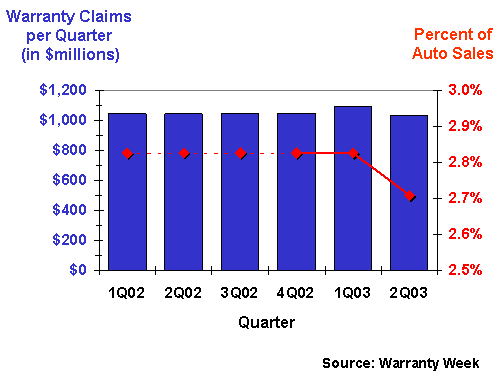
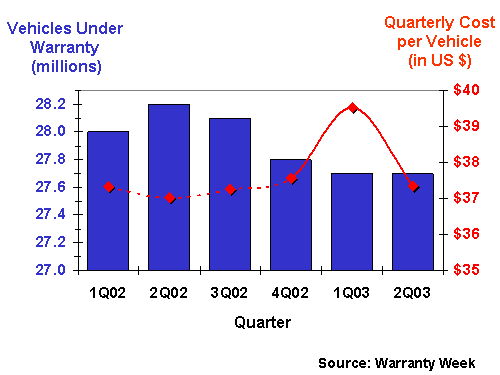
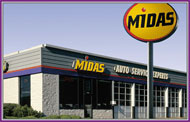 At Midas Inc., an upwards change in estimate cost the company its profitability, at least temporarily. In order to bring the size of its warranty reserve fund up to suitable levels, Midas recorded an upwards $33.3 million change of estimate during the second quarter. The result was a $32.7 million net loss.
At Midas Inc., an upwards change in estimate cost the company its profitability, at least temporarily. In order to bring the size of its warranty reserve fund up to suitable levels, Midas recorded an upwards $33.3 million change of estimate during the second quarter. The result was a $32.7 million net loss.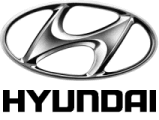 Last year, Hyundai had to increase its worldwide accrued warranty liability to 2,296 billion won, from 989 billion won in 2001 (US$1.91 billion vs. US$824 million). That 130% overall increase impacted net income most noticeably in the second quarter of 2002. Part of the increase was caused by compliance with new vehicle recycling laws in the European Union, but at least 500 billion won came from provisioning for increased claims in the U.S., where the company's long warranties are a prime driver behind increased sales.
Last year, Hyundai had to increase its worldwide accrued warranty liability to 2,296 billion won, from 989 billion won in 2001 (US$1.91 billion vs. US$824 million). That 130% overall increase impacted net income most noticeably in the second quarter of 2002. Part of the increase was caused by compliance with new vehicle recycling laws in the European Union, but at least 500 billion won came from provisioning for increased claims in the U.S., where the company's long warranties are a prime driver behind increased sales.



